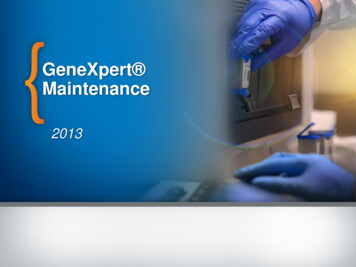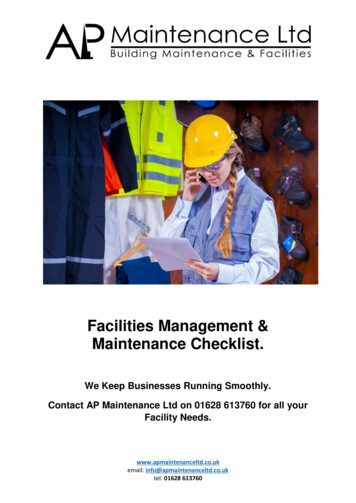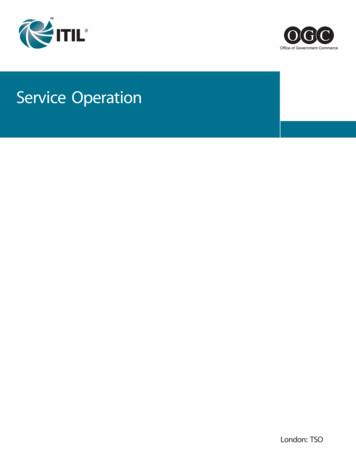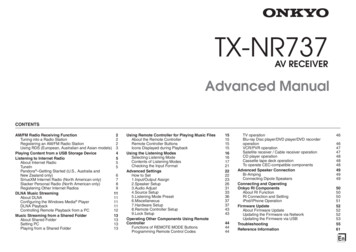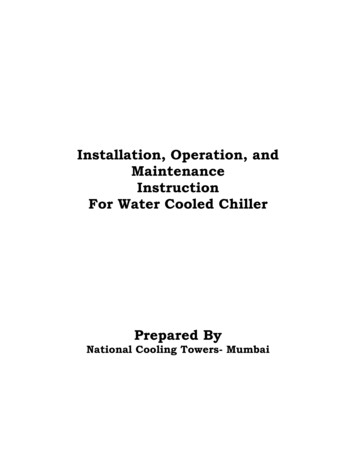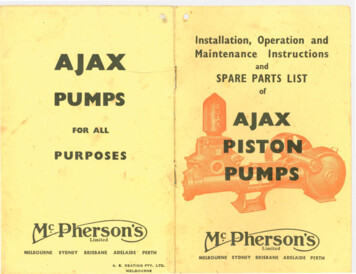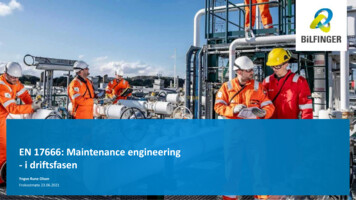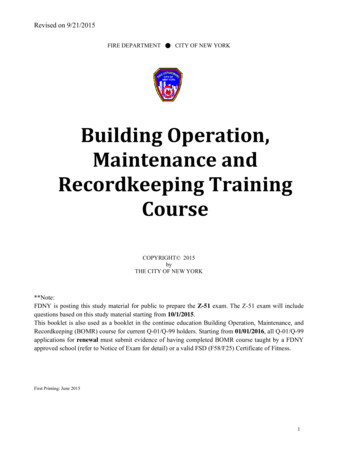
Transcription
Revised on 9/21/2015FIRE DEPARTMENT CITY OF NEW YORKBuilding Operation,Maintenance andRecordkeeping TrainingCourseCOPYRIGHT 2015byTHE CITY OF NEW YORK**Note:FDNY is posting this study material for public to prepare the Z-51 exam. The Z-51 exam will includequestions based on this study material starting from 10/1/2015.This booklet is also used as a booklet in the continue education Building Operation, Maintenance, andRecordkeeping (BOMR) course for current Q-01/Q-99 holders. Starting from 01/01/2016, all Q-01/Q-99applications for renewal must submit evidence of having completed BOMR course taught by a FDNYapproved school (refer to Notice of Exam for detail) or a valid FSD (F58/F25) Certificate of Fitness.First Printing: June 20151
Building Operation, Maintenance and Recordkeeping Training CourseBuilding Operation, Maintenance and RecordkeepingTraining CourseThroughout this booklet, the following terms have the meanings indicated:Fire Code refers to the 2014 New York City Fire Code.Building Code refers to the 2014 New York City Building Code.Mechanical Code refers to the 2014 New York City Mechanical Code.Construction Codes refers to the 2014 New York City Building, Mechanical, Fuel Gas and PlumbingCodes.NFPA refers to the National Fire Protection Association, Quincy, MA.Rule or Rules refers to the Rules of the New York City Fire Department, as set forth in Title 3 of theRules of the City of New York.This training course reference material was written by the staff of the FDNY Licensing Unit with the followingCode Development unit staff who always go the extra mile to help promote the Fire Department’s mission of firesafety:Cindee Tripodi-Azer, Director of Code Coordination and ImplementationJames Hansen, P.E. Director of Code Development2
New York City Fire Code Building Operations, Maintenance and RecordkeepingContentsIntroduction . 7Definitions . 111Module 1: Primary Fire Protection Systems . 14Objectives . 141.1Sprinkler Systems . 151.1.1Introduction . 151.1.2Individuals authorized to perform tasks . 151.1.3Periodic inspection and testing requirements . 151.1.4Recordkeeping requirements . 161.1.5Painting of sprinkler piping (BC903.6) . 161.2Standpipe Systems . 171.2.1Introduction . 171.2.2Individuals authorized to perform tasks . 171.2.3Operation of multi-zone standpipe system . 181.2.4Periodic inspection and testing requirements . 181.2.5Recordkeeping . 181.2.6Painting of standpipes piping (BC905.11) . 181.3Fire Alarm Systems . 191.3.1Introduction . 191.3.2Periodic inspection and testing requirements . 191.3.3Companies and individual certifications . 191.3.4Unnecessary and unwarranted alarms . 201.3.5Recordkeeping . 201.4Out-of-service Fire Protection Systems . 211.4.1Fire watch . 211.4.2Fire guard . 211.4.3Planned removal from service . 221.4.4Unplanned out-of-service condition. . 221.4.5Notification to department. 231.4.6Restoring systems to service . 23Module 1 Summary . 242Module 2: Other Fire Safety-Related Building Systems . 25Objectives . 25 copyright 2015 New York City Fire Department. All rights reserved.3
Building Operation, Maintenance and Recordkeeping Training Course2.1Refrigerating Systems . 262.1.1Introduction . 262.1.2Permits . 262.1.3Supervision . 262.1.4Periodic inspection, testing and maintenance requirements . 262.1.5Recordkeeping . 272.2Emergency Power Systems. 282.2.1Introduction . 282.2.2Individuals authorized to perform tasks . 282.2.3Periodic inspection and testing requirements . 282.2.4Recordkeeping . 302.3Battery Systems . 312.3.1Introduction . 312.3.2Individuals authorized to perform tasks . 312.3.3Periodic inspection and testing requirements . 312.4Smoke Control Systems . 322.4.1Introduction . 322.4.2Periodic inspection and testing requirements . 322.4.3Recordkeeping . 322.5Elevators-in-Readiness . 332.5.1Introduction . 332.5.2Periodic testing requirements . 332.5.3Operational requirements . 332.5.4Recordkeeping . 332.6Non-Water Fire Extinguishing Systems . 342.6.1Introduction . 342.6.2Individuals authorized to perform tasks . 342.6.3Periodic inspection and testing requirements . 342.6.4Recordkeeping . 382.7Means of Egress . 392.7.1Introduction . 392.7.2Maintenance requirements . 392.7.3Operational requirements . 392.8Commercial Cooking Systems . 404
New York City Fire Code Building Operations, Maintenance and Recordkeeping2.8.1Introduction . 402.8.2Companies and individual certifications . 402.8.3Periodic inspection and testing requirements . 402.8.4Permit . 412.8.5Operating instructions . 412.8.6Recordkeeping . 41Module 2 summary . 423Module 3: Other Fire Safety Operational and Maintenance Requirements . 43Objectives: . 433.1Hot Work Operations . 443.1.1Introduction . 443.1.2Permit and supervision . 443.1.3Operational requirements . 443.1.4Recordkeeping . 483.2Flame-Resistant Decorations . 493.2.1Introduction . 493.2.2Operational requirements . 493.3Portable fueled equipment . 513.4Fumigation and Insecticidal Fogging Operations . 523.4.1Introduction . 523.4.2Companies and individual certifications . 523.4.3Operational requirements . 523.5Emergency Planning and Preparedness . 533.5.1Introduction . 533.5.2Fire Safety and Evacuation Plans (FSP). 533.5.3Emergency Action Plans (EAP) . 543.5.4Individuals authorized to perform tasks . 553.5.5Fire drills, EAP drills, FSP staff and EAP staff training . 563.5.6Recordkeeping . 563.6Portable Fire Extinguishers. 573.6.1Introduction . 573.6.2Occupancies or operations requiring portable fire extinguishers . 573.6.3Portable fire extinguisher types . 573.6.4Extinguisher installation . 58 copyright 2015 New York City Fire Department. All rights reserved.5
Building Operation, Maintenance and Recordkeeping Training Course3.6.5Use of fire extinguisher . 593.6.6Fire extinguisher maintenance. 593.6.7Recordkeeping . 603.7 Certificate of Fitness, FDNY Permit, Company Certification and Certificate ofQualification Requirements . 613.7.1Certificate of Fitness (C of F). 613.7.2Certificate of Fitness (C of F) exam information . 613.7.3Fire Code requirements for specific materials, operations and facilities . 633.7.4Fraudulently activity regarding certificates . 64Module 3 summary . 65Appendix A: Applicable Fire Code and Rule Sections and Referenced Standards . 66Appendix B: Sprinkler System Inspection, Testing, and Maintenance . 69Appendix C: Standpipe System Inspection, Testing, and Maintenance . 766
New York City Fire Code Building Operations, Maintenance and RecordkeepingIntroductionScopeThis booklet was developed to be used in the Building Operation, Maintenance and Recordkeeping TrainingCourse. This booklet provides the participant an overview of the 2014 New York City Fire Code requirements forbuilding operation and maintenance, including various provisions of the Referenced Standards adopted in the FireCode.The booklet addresses the following subject matter areas:(A) Module 1: Primary Fire Protection Systems Fire alarm systems Sprinkler systems Standpipe systems Painting of sprinkler and standpipe system piping and valve handles in both new and existing buildings Out-of-service sprinkler, standpipe and fire alarm systems, including impairment coordinator, fire guardand notification requirements(B) Module 2: Other Fire Safety-Related Building Systems Refrigerating systems Emergency power systems Battery system Smoke control systems Elevator in readiness Non-water fire extinguishing systems Means of egress Commercial cooking systems(C) Module 3: Other Fire Safety Operational and Maintenance Requirements Hot work operations Flame-resistant decorations Fumigation and insecticidal fogging operations Emergency planning and preparedness Portable fire extinguishers Permits, certificates of fitness/qualification and company certificationThe graduation test covers the main body (the three modules) of the booklet only. The three appendixes areprovided for reference only. This booklet will not be provided during the graduate test, but reference tablescited from this booklet will be provided.This booklet provides a summary of the fire safety requirements relating to the operation and maintenance ofbuildings. For a comprehensive understanding of such requirements the Fire Code, Fire Department Rules,Building Code, and other applicable laws, rules and regulations must be reviewed in their entirety. copyright 2015 New York City Fire Department. All rights reserved.7
Building Operation, Maintenance and Recordkeeping Training CourseBuilding Operation Maintenance and Recordkeeping CourseAll refrigerating system operating engineers (RSOE) must complete a continuing education course in buildingoperation, maintenance and recordkeeping from a Fire Department-approved continuing education program. Thistraining course shall, at a minimum, provide not less than seven (7) hours of live instruction. This will ensure thatoperating engineers, who typically have other important responsibilities relating to building operation andmaintenance, are familiar with applicable Fire Code requirements, which have undergone a comprehensive revisionin 2008 and were revised again in March of 2014. This course is required of all Certificate of Qualificationholders, including those that may currently not have a work location registered with the Fire Department. AllCertificate of Qualification applications for renewal on or after January 1, 2016 must submit evidence of havingcompleted such course.Refrigeration system operating engineers (RSOE) that are knowledgeable in Fire Code building operation andmaintenance requirements will help foster compliance with the Fire Code in the buildings where they areemployed, thereby making the building a safer place for occupants and emergency responders.What is the NYC Fire Code?The New York City Fire Code is a city law that establishes fire safety requirements for a wide range of activities inNew York City. These requirements govern such matters as the manufacture, storage, handling, use, sale andtransportation of hazardous materials and combustible materials, except for the installation of storage tanks andauxiliary storage tanks for oil-burning equipment; the design, installation, operation and maintenance of devices,equipment and systems designed to prevent, mitigate, control and extinguish fire, explosions or other life safetyhazards; emergency preparedness and planning, including the orderly evacuation of occupants of buildings,structures or premises in the event of fire, explosion, biological, chemical or hazardous material incident or release,natural disaster or other emergency, or the threat thereof; the prevention, mitigation and control of hazards tofirefighters and emergency responders during emergency operations; and the operation and maintenance of anymanual, automatic or other fire alarm or fire extinguishing device, equipment or system.To whom does the Fire Code apply?The Fire Code applies to all persons and places in New York City. Everyone must comply with its prohibitions andfire safety requirements. Persons and businesses that conduct or supervise the activities regulated by the Fire Codemay also be required to obtain permits and certificates that authorize them to engage in those activities.The 2008 New York City Fire Code that took effect on July 1, 2008, was amended effective March 30, 2014.Some of the design and installation provisions of the 2008 Fire Code and the Fire Prevention Code in effect prior tothat may continue to be applicable to certain “pre-existing” installations that will be allowed to remain after theFire Code took effect on March 31, 2014 even though they are not in compliance with the 2014 Fire Code’srequirements. In such cases, the former Fire Code provisions have been, or will be, consolidated in Chapter 48 ofthe Rules for convenient reference.For example,A sprinkler system legally installed in a building before July 1, 2014 will not be required to comply with the newdesign requirements of the 2014 Fire Codes. Pre-existing systems are generally required to comply with theindustry standards and manufacturer requirements in effect at the time they were installed. However, theoperational and maintenance requirements of the 2014 NYC Fire Code must be followed by the building owner forboth pre-existing and new installations. Examples of such: Operational requirements are, recordkeeping, posting of signage and the prohibition on smoking.8
New York City Fire Code Building Operations, Maintenance and Recordkeeping Maintenance requirements are those that relate to keeping equipment and premises in good working orderand a safe condition.How does the Fire Code relate to the Rules and referenced standards?The Fire Department has promulgated numerous Rules to supplement the Fire Code. Rules are necessary in somecases to clarify the intent of the code, but more often they are adopted to implement the authority granted to theFire Department by the Fire Code. For example, Chapter 9 of the Fire Code sets forth the Fire Department’sauthority to require periodic testing of sprinkler and standpipe systems that contain Fire Department connections.Fire Department Rule (R912-01) sets forth the procedures for testing such systems. The Rules also modify therequirements of the Referenced Standards incorporated by reference into the Fire Code. Fire Department RuleR4702-01 modifies the National Fire Protection Association Referenced Standards set forth in FC Chapter 45 toconform them to New York City standards or procedures.Why are periodic fire safety inspections important?Buildings are designed to protect life and property from fire and smoke conditions by incorporating a variety of fireand life safety systems. These systems are only effective if they operate as designed when needed. Periodicinspections are one way to ensure that fire protection systems, life safety systems and other fire safety systems areoperated and maintained in accordance with the Fire Code and Rules, and that such systems are otherwise kept ingood working order.What is a fire protection system?A fire protection system is any system designed to detect, control, extinguish and alert building occupants to fire orfire-related smoke. The primary fire protection systems are sprinkler systems, standpipe systems and fire alarmsystems.Chapter 9 of the NYC Building Code specifies where sprinkler systems, standpipe systems and fire alarm systemsare required to be installed, and the standard for their installation. Whether a building is required to install a fireprotection system generally depends upon the occupancy type, height and area of the building (factors that mostaffect firefighting capabilities) and the relative fire hazard of a specific space or area. The NYC Fire Code requiressprinkler and fire alarm systems in connection with the manufacture, storage, handling and use of hazardousmaterials and other materials, operations and facilities that present hazards to life and property.In order to help ensure the reliability of fire protection systems, the Fire Code prescribes minimum periodicinspection, testing and other maintenance requirements for such systems, and in many cases requires personsperforming such responsibilities to obtain a Certificate of Fitness. The table below identifies several of the morecommon building related certificates. copyright 2015 New York City Fire Department. All rights reserved.9
Building Operation, Maintenance and Recordkeeping Training CourseRelevant Certificate of Fitness/Certificate of Qualification ListTypeDescriptionB-29F-01F-25/F-58Supervision of Battery SystemsCitywide Fire Guard for ImpairmentFire Safety DirectorFire Safety/Emergency Action PlanDirectorFire guard for torch operation and fire guardfor construction site.Torch operationCommercial Kitchen Exhaust SystemCleaning TechnicianRefrigeration system operating engineersCitywide Sprinkler SystemStandpipe System (except multi-zonesystem)Standpipe System, multi-zoneInspection, Cleaning & Testing Of SmokeDetectorsSupervision Of Fire Alarm SystemsInspection, Testing and Servicing of FireAlarm SystemsFumigation and insecticidal foggingoperationPortable Fire Extinguisher alGeneralPersonalPersonalPremises Related orCitywidePremises relatedCitywidePremises relatedPersonalPremises ywideP-64/W-64: CitywideF-64: Premises relatedPremises mises relatedS-78: CitywideF-78: Premises relatedPremises ywidePersonalPersonal10
New York City Fire Code Building Operations, Maintenance and RecordkeepingDefinitionsCertificate of Fitness (C of F)— A written statement issued by the commissioner certifying that the person towhom it is issued has passed an examination as to his or her qualifications or is otherwise deemed qualified toperform one or more of the following duties, for which such certificate is required by this code or the rules:supervise a facility; conduct or supervise an operation; supervise the storage, handling and/or use of a material; orconduct or supervise emergency planning and preparedness activities.Certificate of Qualification (C of Q) — A written statement issued by the commissioner certifying that the personto whom it is issued has passed an examination as to his or her qualifications to direct, control and supervise theoperation of a refrigerating system, for which such certificate is required by this code or the rules.Commercial cooking system—A system consisting of commercial cooking equipment, exhaust hoods, filters,exhaust duct systems, fire extinguishing system and other related appurtenances designed to capture grease-ladencooking vapors.Emergency action plan—A written plan which sets forth the circumstances and procedures for the sheltering inplace, in-building relocation, partial evacuation or evacuation of building occupants in response to an incidentinvolving an explosion, a biological, chemical or nuclear incident or release, natural disaster or other emergency, orthe threat thereof, or a declaration of emergency by a lawful authority.Exit—That portion of a means of egress system which is separated from other interior spaces of a building orstructure by fire-resistance-rated construction and opening protectives as required to provide a protected path ofegress travel between the exit access and the exit discharge. Exits include vertical exits, exterior exit doors atground level, exit enclosures, exit passageways, exterior exit stairs, exterior exit ramps and horizontal exits, but donot include access stairs, aisles, and/or exit access doors opening to corridors or corridors. This term shall includethe locations on a premises at which egress may be had from an enclosed outdoor space.Exit access—That portion of a means of egress system that leads from any occupied portion of a building, structureor premises to an exit. It should be noted that the definition of “Exit access,” unlike the Building Code definition,includes outdoor spaces.Exit discharge—That portion of a means of egress system between the termination of an exit and a public way.Flame-resistant material—Material that meets the criteria for flame-resistance as set forth in NFPA Standard 701,either because it is inherently flame-resistant or because it has been subjected to a flame-retardant treatment.Fire alarm system—any system, including any interconnected fire alarm sub-system, of components and circuitsarranged to monitor and annunciate the status of fire alarm or supervisory signal-initiating devices.Fire drill — A training exercise by which building occupants are familiarized with and/or practice the proceduresfor the safe, orderly and expeditious in-building relocation, partial evacuation or evacuation, as applicable to theoccupancy or building type, in accordance with the fire safety and evacuation plan, and to evaluate the efficiencyand effectiveness of the implementation of such plan.Fire guard—A person holding a certificate of fitness for such purpose, who is trained in and responsible formaintaining a fire watch and performing such fire safety duties as may be prescribed by the commissioner.Fire safety and evacuation plan —A written plan which sets forth the circumstances and procedures for the inbuilding relocation, partial evacuation or evacuation of building occupants, required or as appropriate for suchoccupancy or building type, in response to a fire.
Building Operation, Maintenance and Recordkeeping Training Course 2 Building Operation, Maintenance and Recordkeeping Training Course . maintenance requirements will help foster compliance with the Fire Code in the buildings where they are employed, thereby making the build


